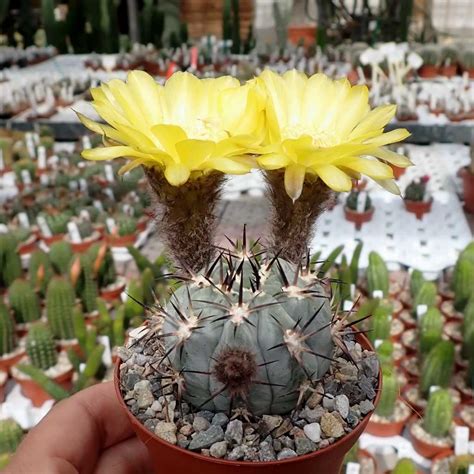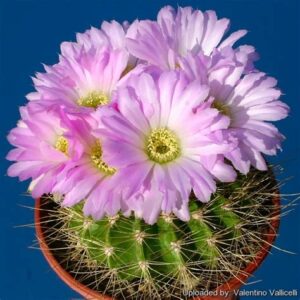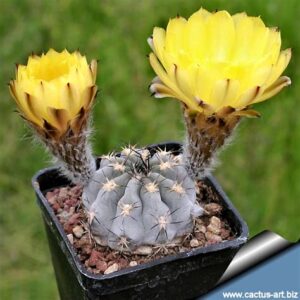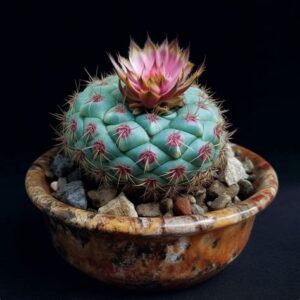Acanthocalycium glaucum rubriflorus emerges like a radiant jewel amid the arid expanse of its native habitat, embodying nature’s artistry with remarkable finesse. Known for its distinctive traits, this cactus is an exceptional piece of botanical beauty that transcends the mundane, inviting enthusiasts to explore its splendor. With its captivating visual charm and intriguing growth habits, the Acanthocalycium glaucum rubriflorus stands as a symbol of resilience and elegance in the world of succulents.
Originating from the sun-kissed landscapes of Argentina, this species belongs to the family Cactaceae and is commonly referred to as a globe cactus. The very name “Acanthocalycium” translates to “thorny calyx,” aptly describing the spine-laden crowns that adorn its spherical body. The rubriflorus variety, in particular, is celebrated for its striking crimson flowers, which blossom in a vibrant spectacle that contrasts beautifully with its muted green-gray body. This juxtaposition captivates the observer, evoking a sense of wonder that is rarely found in the flora of the desert.
The unique appeal of Acanthocalycium glaucum rubriflorus is multifaceted, encompassing its aesthetic value, ecological significance, and cultural relevance. This exploration will delve into the intricacies of this phenomenal species, producing a narrative as enchanting as the cactus itself.
Botanical Brilliance: An Overview of Acanthocalycium Glaucum Rubriflorus
At first glance, Acanthocalycium glaucum rubriflorus intrigues with its stout, globular form. Achieving a height of around 10-15 centimeters and a diameter of up to 20 centimeters, this cactus can be likened to a stout, green cannonball perched atop the sandy soil. The body is covered in a lush coating of glaucous wax, which serves to moderate water loss and protects the plant from extreme environmental conditions.
What truly sets this species apart are its spines. A dense array of needle-like spines encircles the cactus, creating an armor that protects its soft interior. The spines range in color from yellow to reddish-brown, providing an artistic contrast against the soothing green of the body. These fascinating structures are not merely for show; they serve a functional purpose by reflecting sunlight and drawing away herbivorous wildlife, allowing the cactus to thrive in its harsh surroundings.
Floral Array: The Mesmerizing Blooms of Rubriflorus
The pièce de résistance of the Acanthocalycium glaucum rubriflorus is undoubtedly its flowers. Emerging in late spring to early summer, the blossoms burst forth in radiant shades of red, often enhanced with delicate yellow-orange interiors. The blooms are funnel-shaped, opening into a broad, star-like arrangement that seduces pollinators and admirers alike. This floral extravagance often attracts hummingbirds and bees, responsible for the plant’s reproduction within its natural ecosystem.
The blooming period is a remarkable annual event, akin to a fireworks display in the plant world. The flowers last for only a few days, yet during that time, they create a spectacular showcase that captivates the senses. Each flower has a fragrance reminiscent of sweet nectar, adding to its allure. Although fleeting, this display is a powerful reminder of nature’s transient beauty, prompting reflection on the importance of seizing moments of joy.
Adaptations for Survival: Resilience in Arid Environments
The survival of the Acanthocalycium glaucum rubriflorus in its native habitat is a testament to its remarkable adaptations. Thriving in the harsh, arid conditions of Argentina, this cactus has evolved a series of mechanisms to withstand extreme temperatures and prolonged periods of drought.
Its succulent nature allows it to store water within its thick, fleshy tissues, enabling it to endure long stretches without rainfall. During dry spells, the cactus enters a state of dormancy, significantly slowing down its metabolic processes. This capability is akin to a masterful performance in a play, where the cactus assumes a central role but knows when to retreat into the shadows, awaiting the next act of life.
Furthermore, the waxy coating on the cactus surface not only reflects sunlight, reducing water loss through evaporation, but also serves to deter insects. This dual-functioning adaptation illustrates the plant’s sophisticated strategies for survival and flourishing in precarious conditions.
Cultivating Acanthocalycium Glaucum Rubriflorus: Tips for Enthusiasts
Cultivating Acanthocalycium glaucum rubriflorus is an undertaking that merges patience with passion. This cactus holds immense appeal for both novice and seasoned enthusiasts due to its manageable size and striking beauty. To successfully nurture this plant, one must consider several key factors that align with its natural inclinations.
Sunlight is the lifeblood of any cactus. Acanthocalycium glaucum rubriflorus thrives in bright, direct light. It craves the warmth of the sun, much like an artist needs inspiration. Placing the plant near a south-facing window is ideal; however, providing some shade during the hottest hours of the day can help prevent sunburn on its delicate surface.
Watering requires a delicate touch. As a succulent, this species demands a careful watering regimen. During the growing season, it should be watered thoroughly, allowing the soil to dry out completely between waterings. In winter, when the cactus enters dormancy, watering should be significantly reduced, as too much moisture can lead to root rot. Monitoring the soil’s moisture content stands as an essential practice for the cactus aficionado.
Soil choice is critical. A well-draining mix designed for cacti ensures that excess moisture can escape, creating an environment conducive to healthy growth. A blend of potting soil, sand, and perlite offers optimal drainage, mimicking the sandy terrains of its native habitat.
Finally, fertilization should be approached with caution. A diluted, balanced fertilizer applied during the growing season can provide a nutrient boost, yet caution should be exercised to avoid over-fertilization. Each application must be thoughtfully considered to promote robust growth without overwhelming the plant.
Cultural Significance: Acanthocalycium in Human History
The story of Acanthocalycium glaucum rubriflorus extends beyond the confines of botany; it intertwines with cultures and communities throughout history. In many indigenous cultures of South America, cacti are symbols of strength, endurance, and fertility. These resilient plants have lent inspiration to art, folklore, and local customs.
The vibrant blooms of the rubriflorus variety, evoking images of celebration, are often featured in local festivities, embodying the spirit of resilience amidst adversity. They serve as emblems of hope, reminding communities of their interconnectedness with the land and the enduring beauty found within it.
Furthermore, the popularity of Acanthocalycium glaucum rubriflorus extends to the modern gardening scene, where it is embraced by enthusiasts seeking to cultivate unique specimens. Its aesthetic appeal and manageable care requirements make it a standout choice in collections, fostering a deep connection between individuals and the natural world.
A Living Masterpiece: The Enduring Allure of Acanthocalycium Glaucum Rubriflorus
In summation, Acanthocalycium glaucum rubriflorus encapsulates the quintessence of botanical beauty, merging striking aesthetics with an enduring sense of resilience. Its captivating blooms and fascinating adaptations create a living masterpiece that deserves admiration and attention. As nature’s artistry unfolds through the petals and spines of this impressive cactus, it beckons enthusiasts to embrace its magnificence—an invitation to dwell in the sublime splendor of the natural world.





Leave a Comment